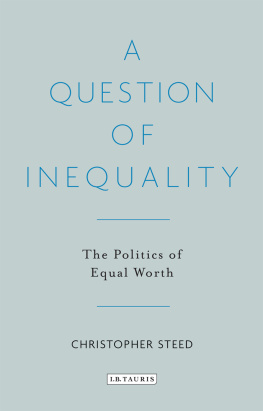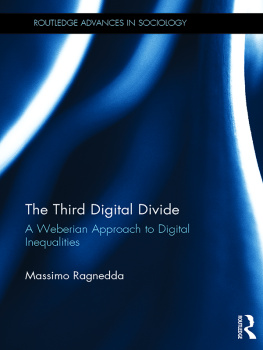SOCIAL INEQUALITY AND SOCIAL STRATIFICATION IN US SOCIETY
Christopher B. Doob
Southern Connecticut State University
First published 2013 by Pearson Education, Inc.
Published 2016 by Routledge
2 Park Square, Milton Park, Abingdon, Oxon OX14 4RN
711 Third Avenue, New York, NY 10017, USA
Routledge is an imprint of the Taylor & Francis Group, an informa business
Copyright 2013 Taylor & Francis. All rights reserved.
All rights reserved. No part of this book may be reprinted or reproduced or utilised in any form or by any electronic, mechanical, or other means, now known or hereafter invented, including photocopying and recording, or in any information storage or retrieval system, without permission in writing from the publishers.
Notice:
Product or corporate names may be trademarks or registered trademarks, and are used only for identification and explanation without intent to infringe.
Credits and acknowledgments borrowed from other sources and reproduced, with permission, in this textbook appear on the appropriate page within text or on page 367.
ISBN: 9780205792412 (pbk)
Library of Congress Cataloging-in-Publication Data
Doob, Christopher Bates.
Social inequality and social stratification in US society /
Christopher B. Doob. 1st ed.
p. cm.
Includes bibliographical references and index.
ISBN-13: 978-0-205-79241-2
ISBN-10: 0-205-79241-3
1. EqualityUnited States. 2. Social stratificationUnited States.
I. Title.
HM821.D66 2011
305dc23 |
2011040457 |
CONTENTS
PREFACE
The title for this book and the subject matter are conventional, but I have sometimes used less common types of sources to help reveal the workings of social inequality and social stratification. They are:
Historical information: Whether the topic is the upper class, the poor, women, or racial minorities, it seems informative to provide historical material. Significant subjects such as the way wealthy individuals deal with the government or the middle classs treatment of the poor or the working class are not patterns that materialized full blown in the twenty-first century. The history of such patterns reveals important clues about why their significance persists. It is comparable to witnessing an actual conversation about a topic instead of just its terse ending. In , an opening section examines major historical events that have influenced current trends. For students the material can be both interesting and instructive.
Qualitative data: To augment the steady flow of quantitative information that forms the foundation of analyses throughout the text, qualitative sources help reveal individuals and small groups thoughts and activities that accompany peoples struggles with the socioeconomic order. Such research is particularly helpful in displaying the complexity of intersectionality, which addresses the impact of two or more statuses on womens lives.
A consistent conceptual skeleton: Individuals success in stratified settings often relies heavily on their access to valued resourcestypes of capital which involve finances, schooling, social networking, and cultural influences. Analyzing the impact of capital types throughout the text helps map out the prospects for individuals, families, and also classes to maintain or alter their economic, political, and social prospects. A steady flow of additional theories or concepts often plays a contributory role.
The text divides into three parts. The opening section contains four foundational chapters, namely an introduction, one about theory emphasizing the centrality of a conflict perspective, another that examines the development and impact of globalization, and a fourth that discusses the conceptual and structural elements underlying social inequality and social stratification. The following six chapters provide portraits of the major Americans classes as well as analyses of how race and gender link to inequalities in the United States. The last chapter considers attempts to reduce social inequality.
At the end of each chapter, I have included a list of important concepts that are highlighted in the previous pages along with discussion topics, research papers, and relevant websites. Clearly there are more activities here than most courses will use. My intention is to give instructors a variety of choices.
ACKNOWLEDGEMENTS
Karen Hanson has been a very effective editor with various contributions to this project. A special thanks to Maggie Brobeck at Pearson, Chitra Ganesan at PreMediaGlobal, and Shirley Jackson at Southern. I am also grateful to Linda Atkinson and Nick Doob for their continuous support. In addition, in doing what she always doescommenting on the entire manuscript and serving as a frequent sounding boardTeresa Carballal has probably been more valuable than ever before. Many thanks to the talented reviewers for this projectDiane Kayongo-Male (South Dakota State University), Steve Marson (University of North Carolina at Pembroke), and Tanetta Andersson (Case Western Reserve University).
Anyone with a comment or question should contact me at doobc1@southernct.edu.
SUPPLEMENTARY MATERIALS
Please visit the companion website at www.routledge.com/9780205792412
The Road to Social Inequality:
A Conceptual Introduction
In Raggedy Dick by Horatio Alger, Jr., the hero, a young bootblack, jumped from a ferry boat into turbulent waters after a small boy, who had fallen overboard. Dick nearly drowned but managed to save the boy and received praise for his courageous act. Shortly afterward the boys father, who conveniently owned a counting house (accounting firm), gave Dick a job at $10 a weekthree times what he earned as a bootblack (Alger 1985, 127). The lad was on his way.
Such fortunate developments typically happened to Algers heroes. They were hardworking, ambitious, intelligent, generous, honest, street-wise, opportunistic boys determined to advance themselves from modest origins to elevated positions in society. Inner drive and talent were the primary reasons for their positive outcomes. In Struggling Upward, Alger indicated that his hero had elevated himself from poverty to wealththat luck played a role, but above all he [was] indebted for most of his good fortune to his own good qualities (Alger 1985, 280).
In the late nineteenth-century era of wide-ranging economic inequality, Algers host of well over a hundred novels about dedicated, high-minded poor young white boys relentlessly seeking fortune and fame was very popular. Many Americans firmly believed that they lived in a land of open opportunity, where the virtue of hard work inevitably produced the rewards of wealth, power, and prestigerags to riches as the phrase goes.
But while such transformations have occurred, the position throughout this book is that select groupshigher-class members, whites, and maleshave had better opportunities and, therefore, more extensive rewardsthan lower-class people, racial and ethnic minorities, and women.
This texts mission is to examine the processes that have produced and sustained those inequalities. Besides the conventional quantitative studies and statistics, the upcoming chapters contain both historical and qualitative sources, broadening and deepening the readers grasp of the topics at hand. In addition, the relentless use of certain conceptssocial reproduction and four types of capital, which are introduced in this chapterhelp to structure a coherent overall organization and to reveal the fine print of American social inequality and social stratification. At this juncture it is necessary to introduce the courses most fundamental concepts.






